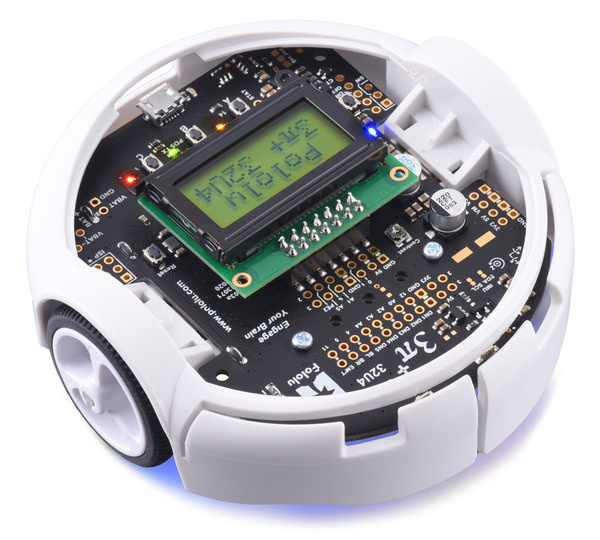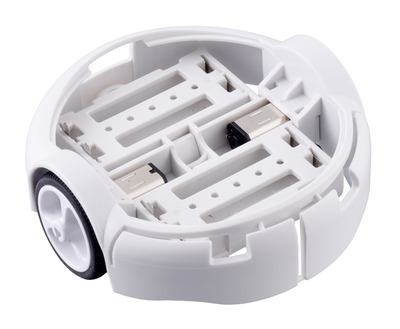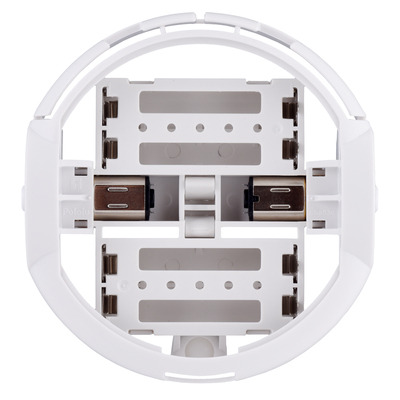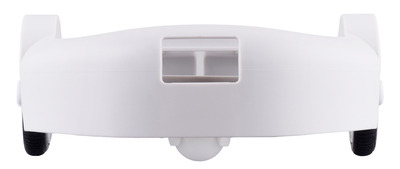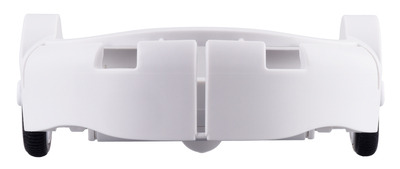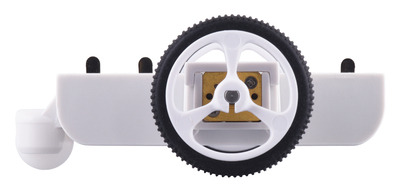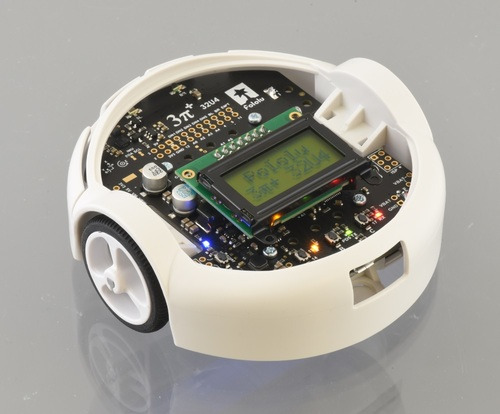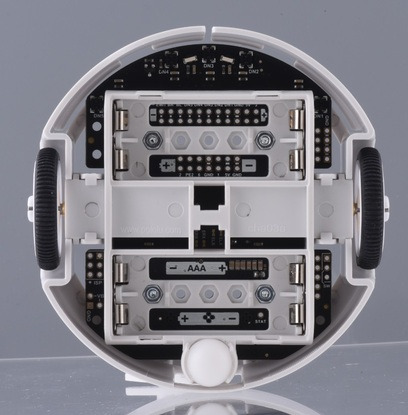Pololu Blog »
Pololu Blog (Page 11)
Welcome to the Pololu Blog, where we provide updates about what we and our customers are doing and thinking about. This blog used to be Pololu president Jan Malášek’s Engage Your Brain blog; you can view just those posts here.
Popular tags: community projects new products raspberry pi arduino more…
Our newest robot, 3pi+, is here—Arduino-compatible, USB, encoders, full IMU and more!
I am thrilled to announce the release of our newest robot, the 3pi+! This new platform is a major upgrade from the original 3pi robot we introduced twelve years ago. At 97 mm, the diameter is just 1mm larger than the original, and the general concept of a tiny, fast robot powered by four AAA batteries and two micro metal gearmotors remains the same. However, just about everything has been redesigned from the ground up to add the extra features everyone has been asking for.
First off, the 3pi+ is now a platform that encompasses a range of products, not just one particular robot. This is enabled primarily by the chassis now being an independent structure rather than being a specific circuit board with motors strapped on:
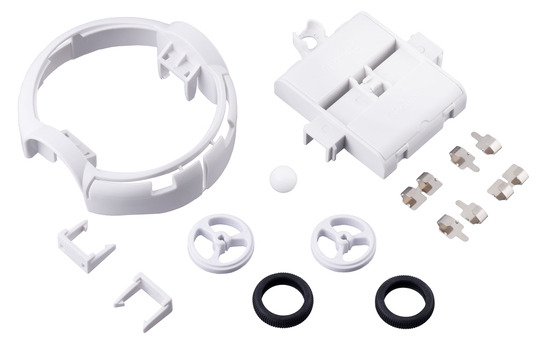 |
3pi+ Chassis Kit (No Motors or Electronics). |
|---|
|
|
|
|
|
|
The chassis incorporates the battery holders, motor mounts, and ball caster. An outer bumper skirt is removable and the motors can instead be held in by separate clips (also included in the kit). The left-most picture shows the chassis with motors installed but without the bumper skirt or motor clips, and the next two pictures show the motor clips installed:
|
|
|
Making the chassis separate from any electronics means that you can use it with your own electronics and that we can make various versions with different capabilities and microcontrollers.
3pi+ 32U4
The first full 3pi+ robot we are launching is the 3pi+ 32U4, which is based on an Arduino-compatible ATmega32U4 microcontroller from Microchip (formerly from Atmel). Like the original 3pi, the 3pi+ 32U4 has five integrated downward-looking reflectance sensors, making the robot a great starting point for line following and line-maze events.
The 3pi+ 32U4 offers many major improvements over the original 3pi, including:
- ATmega32U4 microcontroller with Arduino-compatible bootloader can be programmed directly through a USB connection
- Quadrature encoders on both motors for closed-loop position and speed control
- Full 9-axis IMU (three-axis gyro, accelerometer, and compass)
- Bottom-loading battery holders keep batteries accessible even if additional levels are added
- Full wrap-around bumper to protect electronics from collisions
- Two bump sensors on the front
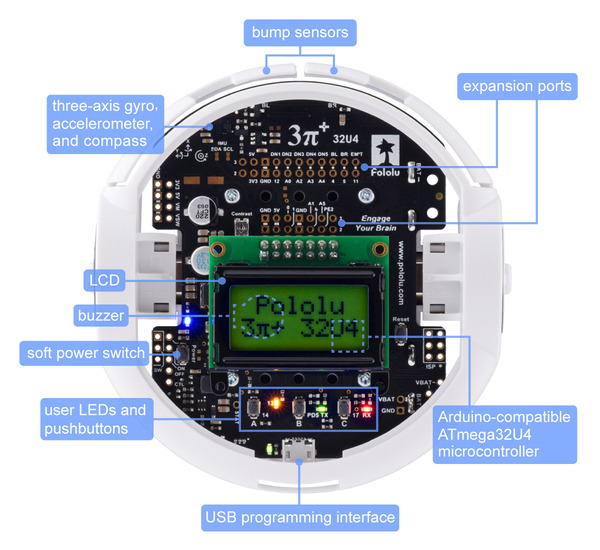 |
3pi+ 32U4 Robot features, top view. |
|---|
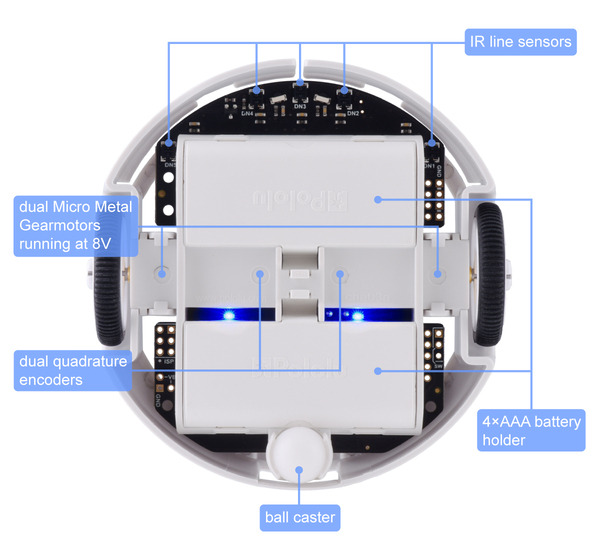 |
3pi+ 32U4 Robot features, bottom view. |
|---|
The 3pi+ 32U4 is also available with three motor options for different usage scenarios:
| 3pi+ 32U4 Version | Products | Micro Metal Gearmotor | Top Speed | Comments |
|---|---|---|---|---|
| Standard Edition | assembled or kit | 30:1 MP 6V | 1.5 m/s | great all-around balance between controllability and speed, with top theoretical speed above that of the original 3pi |
| Turtle Edition | assembled or kit | 75:1 LP 6V | 0.4 m/s | longest battery life, easiest to control, appropriate for swarm robot projects or classrooms where you might not want robots flying around the floor (or desktop) too quickly |
| Hyper Edition | assembled or kit | 15:1 HPCB 6V | ~4 m/s | ridiculous speed, which can definitely be fun. But, controlling that speed can be difficult, which can make the robot more prone to self-destruction (or at least self-inflicted damage), so we recommend this only for advanced users |
These three 3pi+ 32U4 motor options are available in assembled or kit form, and for those who want to do your own thing, the parts are available separately so that you can pick some other motor or gear ratio.
Normally we would have an introductory special for this big of a new product release, but since we are about to launch our annual Black Friday and Cyber Monday sale, you can get a great discount on the new 3pi+ there!
November 2020 update after 8 months of operations under coronavirus
This week marks eight months since business shutdowns began in Nevada in response to the coronavirus pandemic. Here is an update about how we have been surviving at Pololu since my last detailed post in April, when we got our PPP loan.
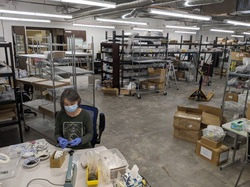 |
We managed to reach a record sales quarter for Q1 despite the last few weeks being under the Nevada emergency measures and February onward being disrupted by the shutdowns affecting our China operations. Sales really dropped in April and even more in May, leading to Q2 sales ending up the worst since 2013. The money we received in April from the PPP loan allowed us to keep paying those employees who were still working and to cover health insurance and other benefits for the rest. We submitted our PPP loan forgiveness application in early July on the day our bank released their application and kept in constant contact with our bank rep while we maintained core operations with a minimal staff.
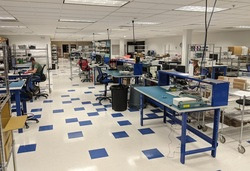 |
The initial loan application had been approved very quickly, so we were hoping to get a resolution on the forgiveness similarly quickly to let us know where we stood regarding how much we would be in debt. We made some tough staffing decisions in July and August, and that turned out to be a very good move because the loan forgiveness process ended up taking a lot longer. We started the year with around 80 employees, and by the end of August, we had reduced that to around 55, of which about ten work only remotely. Everyone else has now formally quit or been laid off, with some hope that most of them could eventually return once the pandemic is under control.
Q3 brought several special high-volume sales, including components going into coronavirus testing equipment around the world, which helped Q3 sales inch past our Q1 sales for a new all-time record sales quarter. Perhaps some of that was also impacted by orders delayed from Q2 and from schools buying more kits for the resumption of classes in the fall. It sure felt like things were going in a good direction, which I guess is how a lot of the world felt.
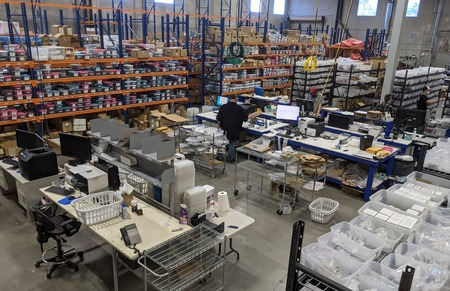 |
The news did not stay good for long as sales dropped a lot again in October, falling below our April low (but not getting as bad as May) as the new wave of COVID cases swept Europe and brought in renewed shutdowns in many countries there. November has so far also been weak as the coronavirus continues to surge across the globe.
We got one bit of good news for Pololu last week when our PPP loan forgiveness went through! We did not get our whole loan forgiven, but it was over 90% of the loan amount, which is a substantial amount of money that covers a lot of our losses from Q2 and lets us approach the end of the year with a bit of cash reserves instead of being in a hole. It’s a huge relief knowing we should be able to ride out the holiday season without having to do further layoffs.
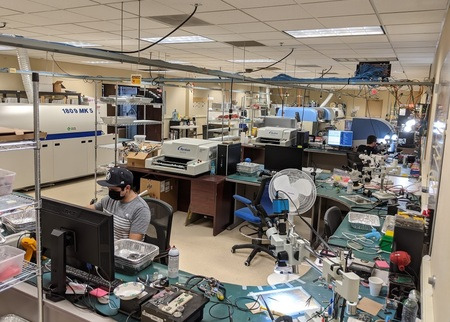 |
We are of course working hard to do more than just to get by for another few months. Some of the staff we brought back in the summer are working on new and exciting products, including resumption of projects we had been working on long before the coronavirus hit. We have not even done proper announcements of some of the items that are already released, including our 3-channel wide field of view (FOV) distance sensor module.
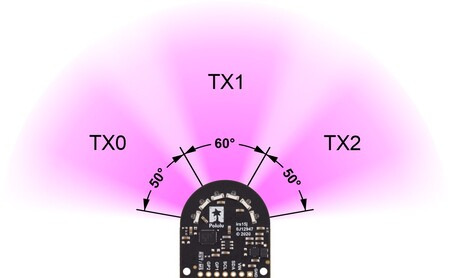 |
That was a very challenging project that I still intend to write about in a separate blog post. Right now, I have one more product to tease that we are pushing to release in time for the holidays!
|
|
Speaking of the holidays, normally we would be gearing up for our biggest sale of the year, our Black Friday/Cyber Monday sale that has run from the Wednesday before Thanksgiving through the following Monday. This also made that period very busy for our shipping and manufacturing departments. Since we are working with a reduced staff this year and many people are already stretched thin covering multiple roles, we will be scaling back the intensity of the sale and running it longer in the hopes of distributing the load on those departments. Last year, we introduced a design-your-own-doorbuster promotion, and that was pretty fun to run, so we’ll try to do that again (though we’ll probably be less open to selling things at a loss just to be in the holiday spirit).
Only six more weeks of this crazy year to go! I am so grateful to everyone who has helped us get this far, from all the customers who kept ordering to the employees who stuck with me through the scariest times to everyone who has made a donation. Thank you very much and stay healthy and safe, everybody!
New product: VL53L3CX Time-of-Flight Multi-Target Distance Sensor Carrier
December 2020 update: ST originally specified a 3 m (10 ft) maximum range for the VL53L3CX, and we initially released this product with the name “VL53L3CX Time-of-Flight Multi-Target Distance Sensor Carrier with Voltage Regulator, 300cm Max”. However, they have since released an updated API with software improvements that increase the maximum range to 5 m (16 ft), so we have updated the name of this product accordingly. The latest version of the API should enable this increased range on existing boards as well as new ones; the hardware has not changed.
Please note that the rest of this post has not been updated to reflect the increased 5 m range (which now exceeds the VL53L1X’s 4 m range).
We are now offering a VL53L3CX Time-of-Flight Multi-Target Distance Sensor Carrier. The VL53L3CX is one of ST’s latest ranging sensors featuring their FlightSense technology, which determines distance by measuring how long it takes for emitted light to be reflected from a target and arrive back at the sensor. It can work at distances of up to 3 m, putting the VL53L3CX’s effective range in between those of ST’s older VL53L1X and VL53L0X integrated lidar modules.
Beyond just being an intermediate option, the VL53L3CX is interesting because it has the ability to detect multiple targets within its field of view. This is possible because instead of picking out a single distance based on the reflections received by the sensor, the VL53L3CX outputs histogram data representing how much reflected light it is receiving within different time intervals. The host processor can then read this data through a digital I²C interface and analyze it using special algorithms that ST provides as part of their VL53L3CX API.
This enhanced capability does come at a cost: the added complexity of the histogram processing means that the host requires much more RAM and program memory, making the VL53L3CX difficult to use with small microcontrollers. In our testing, we were unable to fit the VL53L3CX API on a typical 8-bit Arduino, and we are not providing an Arduino library to support the VL53L3CX; therefore, we recommend sticking with the VL53L1X or VL53L0X for applications with similar constraints. However, if you have more resources available on something like a 32-bit processor, the VL53L3CX’s multi-target detection might give you valuable information beyond what you could determine from a distance reading alone.
For more information about the VL53L3CX carrier, see its product page. The first 100 customers can use VL53L3CXINTRO to get up to 7 units for just $7.77 each!
Starlite by Grant Grummer
Grant Grummer used our laser cutting service to create 6- and 8-point acrylic stars for his project, Starlite: A programmable star-shaped canvas for displaying light patterns.
Starlite uses a 3mm thick laser-cut piece of translucent white acrylic (#7328 white, also called “sign white”) for the front face. The LEDs mount onto a thinner (1.5mm thick) piece that has rectangular cutouts that allow the LEDs to connect to the controls, the main control board, and an UPduino daughter board.
You can read more about Starlite on Grant’s Make: Projects and GitHub pages.
If you are interested in making a similar light display, be sure to check out our selection of LED strips!
PULSE: A pendant to warn you when you touch your face
 |
PULSE pendant by JPL. |
|---|
PULSE is a 3D-printed wearable device designed by JPL that vibrates when a person’s hand is nearing their face. It’s based around our 38 kHz IR Proximity Sensor, and was designed to be relatively easy to reproduce (it doesn’t require a microcontroller or programming, but you do need access to a 3D printer to make the case). The project is open-source hardware, with complete instructions, design files, and a full parts list available on GitHub.
These are the parts that can be purchased from Pololu:
- Pololu 38 kHz IR Proximity Sensor, Fixed Gain, High Brightness
- 10×2.0mm or 10×3.4mm shaftless vibration motor
- Mini Slide Switch: 3-Pin, SPDT, 0.3A
- Wire
Here’s a short demo of our intern Curtis using a PULSE pendant he made himself:
You can find more information about the PULSE pendant on the PULSE website.
First new products under emergency operations - new servo wheels!
We are into May, and after almost 8 weeks of shutdowns and emergency operations, most of the world’s attention seems to be moving toward reopening and how to return to some semblance of normal, or at least longer-term sustainable operations. With no particular medical solution even on the horizon, it’s clear that we have a long way to go, and a city like Las Vegas is going to be hurt especially hard and for a long time by changes people will adopt until they are comfortable flying for fun again. Pololu has managed to hold up much better than I initially feared during the first week of mandated shutdowns, and I am especially grateful to all of our customers and staff members who have worked hard to get us this far.
It is with this backdrop of gratitude for making it this far while realizing we still have a long way to go that I am especially excited to announce our first new products released since the pandemic hit!
 |
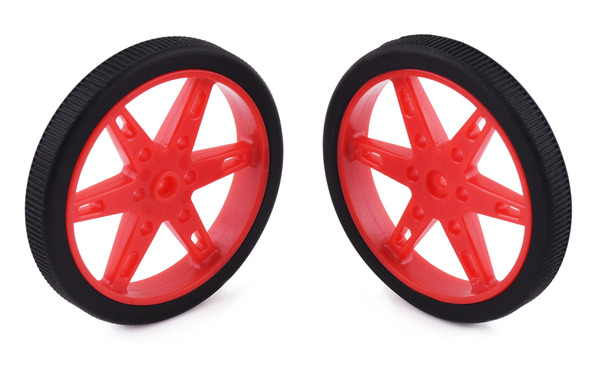 |
 |
 |
In all, we have eight new wheels for micro and standard sized servos. These are red and white versions of the four sizes we released in black back in January. Since we are operating with a minimum staff on site, we don’t have many actual pictures of the new wheels in action, so I will use the pictures with older black wheels for the rest of the post.
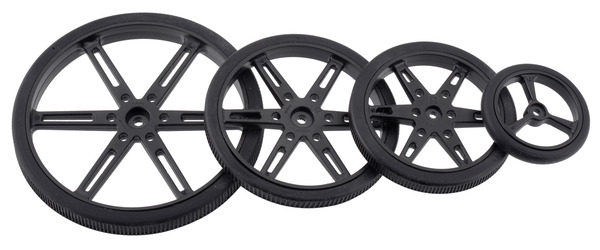 |
Black Pololu Wheels for Standard and Micro Servos – 90, 70, 60, and 40 mm diameters. |
|---|
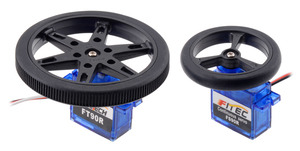 |
We have small, 40 mm and 60 mm sizes that are compatible with micro servo splines with 20 teeth and a 4.8 mm diameter and can be used with the following continuous rotation servos that we carry:
- FEETECH FS90R Micro Continuous Rotation Servo
- FEETECH FT90R Digital Micro Continuous Rotation Servo.
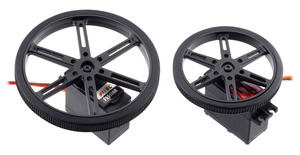 |
We have larger 70 mm and 90 mm sizes that are compatible with standard servo splines with 25 teeth and a 5.8 mm diameter and can be used with the following continuous rotation servos we carry:
- FEETECH Continuous Rotation Servo FS5106R
- Power HD Continuous Rotation Servo AR-3606HB
- SpringRC SM-S4303R Continuous Rotation Servo
- Parallax Feedback 360° High-Speed Servo
If you plan on using the wheels with a servo not listed above, be sure to check your servo’s specifications for compatibility as servo splines are not standardized.
I was never especially fond of continuous-rotation servos, but there’s no denying that they’re often a quick and relatively simple way to get something moving, both from the electronics side (since the motor controller is built into the servo) and the software side. I am a fan of building your own unique robots, so I am happy we now have a range of size and color choices to give you more problem-solving options and variety in your robots.
Like many of our plastic products, these wheels were designed by us in Las Vegas and then injection molded in China. Since we already had the design and molds finished before we released the black versions, these new products are not the most new from a design perspective. We made the black ones first, and red and white were supposed to follow shortly after the Chinese New Year holiday. As we all got reminded, things don’t always go according to plan. And now, what should have been a minor new product has additional sentimental meaning as our first new product since the coronavirus upended our lives and a symbol of our determination to carry on.
We had been announcing new products along with introductory discounts for the last few years, and I wavered for a bit about doing extra discounts for these wheels. Shipping costs have gone up dramatically, and we’re trying to raise whatever money we can, so extra discounts are not the first thing I felt like doing. But the whole point is that we do want to celebrate at least a little! So, hooray for the continuation of the new product discount tradition:
The first hundred customers to use coupon code SERVOWHEELS can get 22% off up to 3 pairs of each size! And, if you are one of the lucky ones not especially financially hurt by the pandemic and are interested in these wheels, please consider getting them without the coupon or even donating to help Pololu keep operating. We have set up item 2400 for donating in $1 increments.
Thank you to all of you who have donated to us or otherwise supported us over the past two months. Stay safe and healthy, everybody!
Rethinking open source in the context of the coronavirus pandemic
We are into week 6 of emergency operations. Our day-to-day routines are largely unchanged from what they were last week (we continue to ship all orders on time with a reduced on-site staff), so please see my earlier posts for more details about that. After more than a month of a new normal setting in, we are striving for a balance of avoiding complacency in daily operations while planning for a future that will likely never be back to how things were a few months ago.
One of our team members passed away (probably not directly related to the coronavirus)
On the complacency front, we were reminded of the stakes when one of our employees unexpectedly passed away at the end of last week from a sudden illness that, from the limited information we have available, was not related to the coronavirus. She was not part of our reduced, on-site staff, so I last saw her in person six weeks ago, and she was in contact a few weeks ago. As the toll of the pandemic mounts, more and more of us are going to be hit increasingly personally, from losing jobs and businesses to missing out on pivotal moments like being present at a child’s birth, to literally life and death experiences made even more painful by new restrictions on being with loved ones and being able to mourn.
However things play out and however bad they get, let’s try to be part of making things better. We can be responsible, supportive, useful, thoughtful, helpful. Many of us are suffering, and probably the only ones not afraid are the ones too unaware to know they should feel some fear. But we can acknowledge the fear without letting it completely overpower us, and we can still look for places in our lives where we can make a difference and decide to make things better.
Rethinking open source in the context of the coronavirus pandemic
 |
The rest of this post is about a longer-term strategy I am thinking about in response to the pandemic: moving toward more open-source projects (both for software and hardware). I would very much appreciate any thoughts and advice people have on the subject.
I wrote about open-source hardware exactly eight years ago this week. I just read it for the first time in maybe five years, and although I feel like I could have written the same thing recently, in many ways I’m a different person than I was then, with the usual progress one would hope for from living another 25% longer, supplemented with extra jolts to my system from things like my baby dying the day before he was born over five years ago and the coronavirus pandemic we have all been shocked by this year. It took me most of those five years to really be able to move on from Dez dying, and when I was locking up Pololu on the Friday a month ago after the first week of escalating government-mandated shutdowns, I really thought I might not be reopening it for weeks and that there would be little chance of Pololu surviving.
Having weathered the past five weeks of emergency operations and being one of the lucky businesses to get temporary funding via the Paycheck Protection Program (PPP loan), my outlook about Pololu making it has substantially improved, and with solvency likely assured for at least a few months, I am thinking about strategic changes for medium and long-term survival in a very different world where the future looks especially uncertain. Here are some of the changes to the world and to Pololu that make open-source projects much more compelling than eight years ago:
Longer-term changes preceding the coronavirus pandemic:
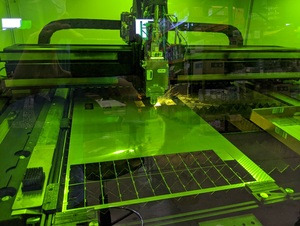 |
Laser cutting Zumo blades at Pololu on 22 April 2020. |
|---|
- Pololu’s manufacturing capabilities and sophistication have improved substantially over the past 8 years. (I still believe that open-source hardware makes more business sense for those with manufacturing capability since competitive advantages would move from product design to production capability, which is more difficult to copy.)
- Copies of our products and documentation and other IP have become a big problem. Even in cases where there might not have been outright fraud intended (e.g. counterfeits being falsely sold as products made by Pololu), consumers of knock-offs take up our support staff time, introduce confusion and uncertainty among customers who have genuine versions of our products, and generally dilute the value of our brand. At least for some products, it might be more pragmatic to officially open up the designs than to fight the copies.
- Our brand and processes and relationships (e.g. with our distributors) and other aspects of being a successful business have grown. This gives us value and competence beyond our designs, so opening them up would be less of giving everything away and undermining our ability to remain in business.
Previously-known arguments for open source that have new weight because of the pandemic:
- Given the increased likelihood that many companies will go out of business, having open-source products can give potential customers more confidence in designing our products into their own products or curriculums. Even if Pololu were to go out of business, at least our designs could get produced somewhere else with less effort than having to design in a new product.
- Employees working on the products might be more motivated to work on them since continued existence of their creations would be less dependent on Pololu continuing to make them.
New arguments for open source specifically because of the coronavirus pandemic.
- Pololu was not particularly well set up for remote workers. While we are working on improving the situation, security and similar concerns might add more friction that would continue to make some kinds of remote work/projects impractical. If they were instead completely open-source projects independent of Pololu, security (as far as keeping designs secret) and supporting external connections to Pololu internal systems would be less of an obstacle.
- We have been soliciting donations to help Pololu survive this crisis. Potential donors might be more encouraged to donate if they had some confidence that they are supporting existence of products and designs that will continue being available even if Pololu were to stop manufacturing them.
- There are now many more people out of work (whether paid or not) around the world who might be open to donating their time and expertise to help on Pololu projects.
- There are now many more students at home or recent graduates without jobs or internships that could especially benefit from looking at or contributing to our designs.
- The pandemic has increased awareness about potential benefits of manufacturing locally, or at least being less dependent on one region or country. Perhaps that will alleviate some of the price pressure that makes it more difficult to open up designs (if you have to compete with the cheapest place in the world to make something, it’s harder to just give them your design).
In short, the heightened uncertainty about business collapses, shortage of money, and physical separation/decentralization that the coronavirus crisis is forcing on us all substantially tip the balance in favor of moving toward more open source projects in organizations like Pololu.
I would appreciate any advice or thoughts any of you have on the topic. Here a few areas you might be able to comment on:
- What do you think in general?
- I am considering specific product-based fundraising campaigns in which we could open up some existing products after exceeding some donation threshold; how does that sound?
- Are there some existing open-source projects that you would like Pololu to start contributing to or manufacturing?
- What’s the latest on open source hardware, in terms of standard licenses, business models, examples, etc? (I generally feel like I hear about open source hardware less than I did 8 years ago, and that there have been some notable disappointments/sell-outs that have dampened the movement, but perhaps I just have not been paying as much attention.)
- What are the best open-source software tools for electronic CAD and mechanical CAD?
- Are there notable recent success stories in terms of open-source physical products?
- Are there any notable examples of companies or organizations attempting to produce open-source physical products?
Thank you for your continued support, everybody! We are working hard to be worthy of it and to do our part to make things better.
Coronavirus impact update: we got our PPP loan!
We are still shipping all orders
After almost a month of emergency operations, during which we have continued to ship all orders, our Paycheck Protection Program (PPP) loan came through, which should buy us at least another several months of continued operation! I will get to more about that later in this post, but first, here is a summary of how we have gotten this far:
- 22 March 2020 – initial COVID-19 impact update and appeal for donations after the first week of emergency operations, when I thought complete shutdown of Pololu operations was imminent.
- 29 March 2020 – update after two weeks:
- We are still operating, with every order shipped! – with tips on how to check stock and look for similar products on our site
- Thank you to everyone who has donated – with extra details about how donations help beyond immediate dollar value
- Landlord/building situation – detailed explanation about how we ended up in the building we are in and why we cannot expect any immediate help from the landlord
- SBA loans/stimulus package – some thoughts on emergency loans we are applying for
- Outlook and plan for now – generally still applicable now (13 April)
- How you can help
- 6 April 2020 – update after three weeks:
- Thank you for your continued donations
- Employee update – with details about how we are supporting our employees
- Pictures of life at Pololu
PPP loan extends our ability to keep operating at least a few months!
The main big news for us is that our Paycheck Protection Program (PPP) loan went through, which should guarantee that we can meet our minimal expenses for at least a few months even if we had to completely stop operations in Las Vegas. This also gives us some breathing room to plan a month or two down the road instead of just day to day or week to week. One of the main questions facing us regarding the loan is how much of it will remain a loan and how much might be forgiven. It looks like our options range somewhere between these two extremes:
- Continue keeping expenses to a minimum. This might reduce how much of the debt is forgiven, so we’d get hit by big loan repayments starting in about six months. On the plus side, we’d at least have the money to work with. And if some longer-term disaster recovery loan comes through and could absorb this loan, that would at least stretch out how quickly we have to repay the money. As it stands, everything would have to get repaid within about two years.
- Spend as much of the money as possible (on qualifying expenses, mostly payroll). This might get more of the debt forgiven, which is obviously a plus. On the other hand, we’d be out of money sooner, with no guarantee of when we might be able to get more. And it would be especially bad to end up with the money spent but still be on the hook for repaying it.
The exact rules for what will be forgiven are still getting clarified, so this is adding yet another level of uncertainty that makes any decision making difficult. Still, after four weeks of scrambling to have a plan for the next day and then the next week, it feels like a luxury to be able to even be talking about next month, even if we do not know when more people will be able to start going back to work again.
What’s clear is that while a loan might buy us some short-term time, we still need to figure out a way to operate profitably with the various restrictions that are likely to stay with us even as states and countries begin reopening their economies.
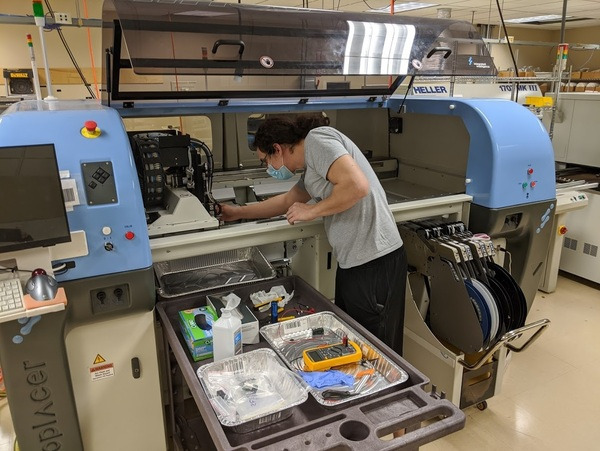 |
Pick and place machine maintenance, 9 April 2020. |
|---|
Thank you for your continued donations 🙏
I am very grateful for the donations that continue to come in. There are too many for me to respond to individually, even for those of you I know! So, sorry I am not able to say so individually, and please know that I do see them coming in and that it means a lot. They have helped us get through the first rough month, where there were days (especially early on) where I really thought Pololu would not be able to make it through. I know it cannot be part of the long-term plan, but given the extraordinary time we are going through, every bit helps to give us a bit more time and a bit more encouragement.
If you can, please consider donating to help Pololu make it through this challenging time and to emerge stronger than ever. We have set up item 2400 for donating in $1 increments.
Other ways you can help (mostly copied from last post):
Pay now, ship later
We have added a feature to our online checkout system to allow for orders to be placed with a “pay now, ship later” option that lets you authorize us to charge the payment for an order as soon as it comes in, possibly well ahead of when the order would actually ship. We started working on this feature at a time when we thought complete shutdown of our operations was imminent, when it might have been weeks or even months before we could reopen. As I wrote at the top of this update, we have been able to ship all orders, and I expect to continue shipping, but this option still allows us to prioritize shipments and reduce stress with orders that come in later in the day and can get shipped the next day. We have already received dozens of orders with this option selected, and it is also encouraging just to see that our customers are trying to help us out. Thank you to all of you who have selected that option!
Order non-soldered versions of products, or the higher-stock versions
We offer a few of our products with some of the optional (but usually used) through-hole connectors soldered in. If you are able to solder, please consider ordering the non-soldered versions if there is plentiful stock of them. We do all of the through-hole soldering by hand, and most of our manual assemblers were older or otherwise in the higher-risk population for COVID-19, so they are not currently working here. And if you’re at home doing a non-critical project, now is a good time to do a little extra soldering, right?
On a related note, it’s a little bit easier for us if you order the item that has more stock. Each product page has links to relevant parametric comparison tables that can help you identify similar products that might have more available stock:
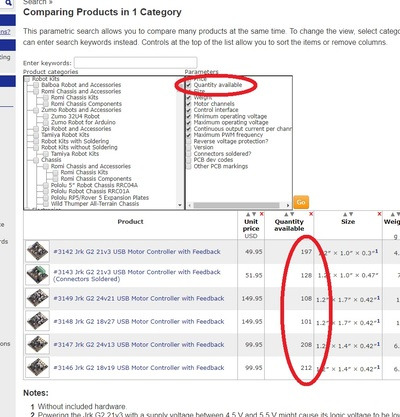 |
You can check available quantity of similar products on the parametric comparison table. |
|---|
If your application could get by with either an item of which we have 300 in stock or one of which we have 12 units, please get the product that we have much more of. It’s probably a more popular version that we make more often, and it keeps the less popular version available for those who might really need it.
Help each other on our forum
We have had to severely cut back on our technical support. If you are one those people with extra time on your hands now and are familiar with any of our products, please consider helping out our other customers on our forum.
Ask others to help us out
If you know anybody that could afford to help us out, please let them know and ask them to contribute.
Other suggestions and ideas
Part of the reason I have been going into more details in some areas of these updates is so you might be able to better give us advice about how we could make things better. Maybe you’re also working at a small business facing similar challenges, and you have some good suggestions. Maybe your uncle has a vacant building nearby. One suggestion I’ve heard repeatedly is about gift certificates, which we are looking into; if you know of particularly good ways of implementing that or things to be careful about, please let us know.
Thank you all for your support. Stay safe and healthy, everybody!
COVID-19 impact update: still hanging on after three weeks
Monday, 13 April 2020 update – we got our PPP loan!
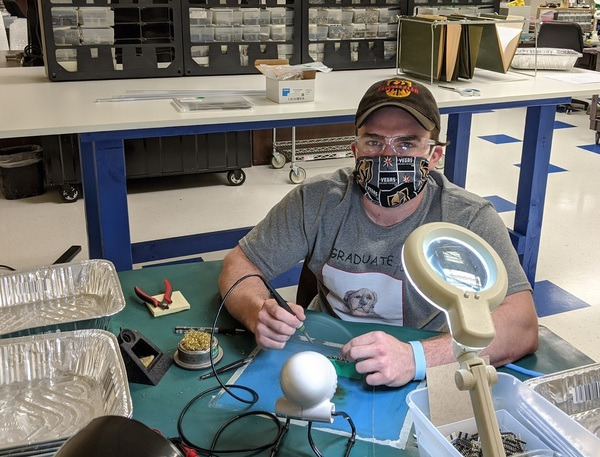 |
After 3 weeks of emergency operations, we are still shipping all orders!
Today, April 6, marks the beginning of our fourth week of emergency operations. We are still hanging on, and it looks like we will be able to maintain operations similar to those of the past three weeks (i.e. continue shipping all orders with a minimal staff on site) at least through the end of April, by which point I hope some of the emergency loans we have applied for might start coming in.
Today I am just posting some quick updates about frequently asked questions; please see my last two posts for more information about how we are coping with the coronavirus emergency:
- 22 March 2020 – initial COVID-19 impact update and appeal for donations after the first week of emergency operations, when I thought complete shutdown of Pololu operations was imminent.
- 29 March 2020 – update after two weeks, with a few sections:
- We are still operating, with every order shipped! – with tips on how to check stock and look for similar products on our site
- Thank you to everyone who has donated – with extra details about how donations help beyond immediate dollar value
- Landlord/building situation – detailed explanation about how we ended up in the building we are in and why we cannot expect any immediate help from the landlord
- SBA loans/stimulus package – some thoughts on emergency loans we are applying for (a little more info in today’s post)
- Outlook and plan for now – generally still applicable a week later
- How you can help
- 6 April 2020 – this post
- Thank you for your continued donations
- Please help reduce overwhelming workload
- Emergency loan updates
- Employee update
- Pictures of life at Pololu
- How you can help (mostly repeated from last week’s post)
Thank you for your continued donations 🙏
We are very grateful for the many donations that continue to come in. As we trim our expenses, those donations become a larger fraction of what we need to get by. I know it’s asking so much for donations with no strings attached, and it means a great deal at a time when we are scrambling to make ends meet. To the many of you making us special proposals and suggestions, thank you and please keep them coming. We do not have the resources now to reply to them individually, but they do affect what we are considering offering and how we continue to operate.
If you can, please consider donating to help Pololu make it. We have set up item 2400 for donating in $1 increments.
Please help reduce overwhelming workload (for those of us who can work)
We are especially grateful for any routine orders that do not require special considerations. We are also happy to help with emergency orders involving efforts to fight the pandemic. For smaller, non-emergency inquiries, please understand that we are trying to maintain most of our usual operations with a much more limited staff while having to take on a lot of extra work (new HR issues for navigating layoffs vs. waiting for possible stimulus funds, coming up with new operating/safety procedures, rerouting incoming and outgoing packages among constantly changing rules for each country and carrier, etc.). Please help us reduce our workload by cutting back on non-critical inquiries. For regular orders, prices and stock are all on the web site. Tracking numbers are included in shipment confirmation emails. Invoices are available on the website when you log in. For technical support, please consider our forum.
Emergency loan updates
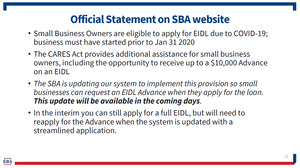 |
One of the most common questions or recommendations we get is about applying for emergency loans. We applied for an SBA economic injury disaster loan (EIDL) almost two weeks ago and followed up with the $10k advance application provided by the new CARES Act. We have been working with our bank all weekend to apply for the new Paycheck Protection Program loan, the applications for which have just started becoming available. My understanding is that the SBA is also scrambling as it is suddenly charged with processing more than 10x what they usually do over the whole year over the next several weeks. We received some confirmation about the EIDL loan being received but there’s been no visible progress on that, and in general, it’s difficult to know what to expect in terms of if, when, and how much we might be able to receive in emergency loans.
Given that uncertainty, it is especially urgent for us to cut costs where we can and to bring in whatever money we can to keep covering basic expenses. We are definitely hoping we qualify for some assistance and that it will come soon, so we are doing everything we can to keep all those applications moving forward while also trying to maintain operations independent of any guarantee of anything coming from that.
Employee update
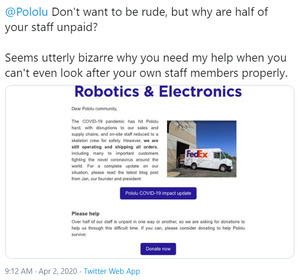 |
We received a few responses questioning our treatment of employees while asking for donations. They are far outnumbered by positive responses, and I suspect the negative responses come from people who have little appreciation of the realities of running a small business, especially amid this level of disruption. Nevertheless, I believe more people might be wondering about what we are doing, and I am proud of our response given the circumstances, so I would like to highlight what we have done so far.
Some of the responses questioned the “over half of our staff is unpaid in one way or another” phrasing. We had about 75 employees at the beginning of March, and over half of them are now either laid off, on unpaid leave, or volunteering to take a pay cut. This is just a basic reality of payroll being by far our biggest expense, and if people cannot come in to work and money stops coming in, there is nothing to pay them from. We are doing everything we can to keep Pololu in a viable state so that there is something for everyone to come back to in a few weeks or months.
Here is some of the rest of our response:
- Prior to any Nevada mandates, we began staggering our workbenches, improving sanitizing procedures, and set up some employees for working remotely.
- Within the first day of the Nevada governor’s emergency business closure declaration, we set up an emergency forum for all employees to be able to communicate without being on site. I have been posting there almost daily to keep everyone in the loop on our operations and outlook.
- We contacted all employees to make sure we had their contact information and understood their preferences about working (different people have different preferences based on their living arrangements, risk factors for COVID-19, etc.).
- We are maintaining health insurance and similar benefits for everyone who had them, including paying the employees’ portion for those who could not work and were out of paid time off (PTO). Some employees who were scheduled to begin getting coverage through Pololu are still getting added to our plans.
- We paid out remaining PTO to those laid off.
- We are maintaining PTO for those on unpaid leave and those still working.
- We paid full amounts due to those still able to work (excluding those volunteering for pay cuts).
- We are continuing safety assessments for on-site operations, including providing face masks for all on-site staff.
- We are working on improving remote connection and work capability.
Pictures of life at Pololu
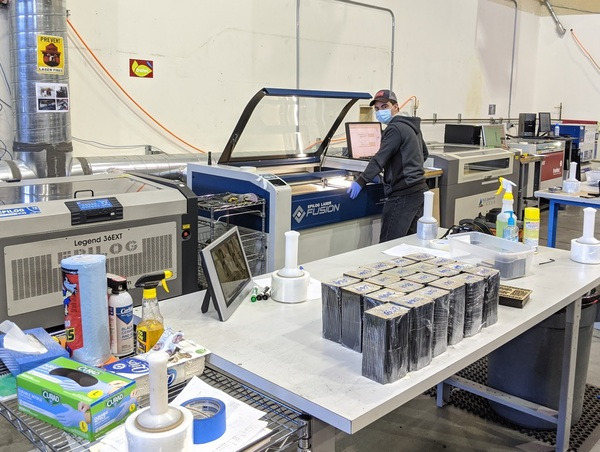 |
Pololu laser cutting department on 6 April 2020. |
|---|
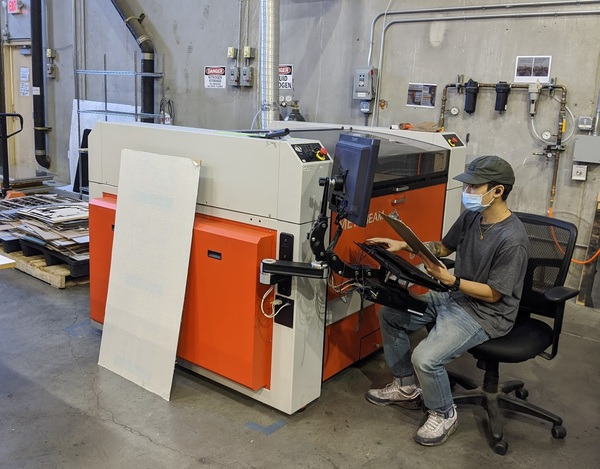 |
Pololu laser cutting department on 6 April 2020. |
|---|
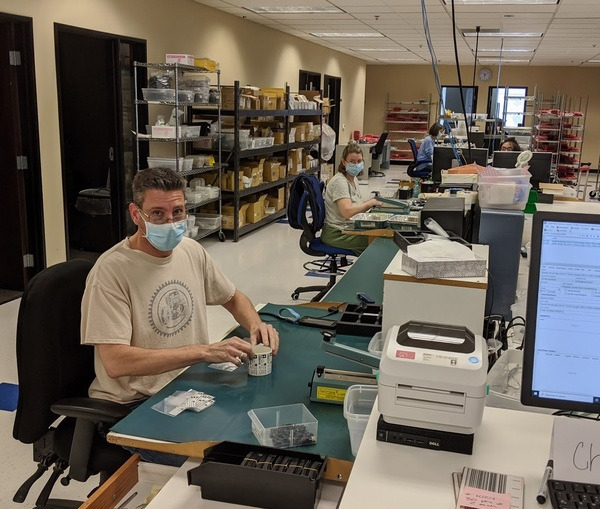 |
Pololu packaging department on 6 April 2020. |
|---|
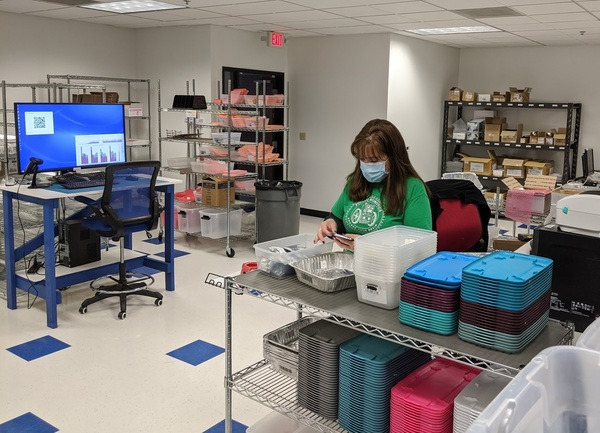 |
Pololu quality control on 6 April 2020. |
|---|
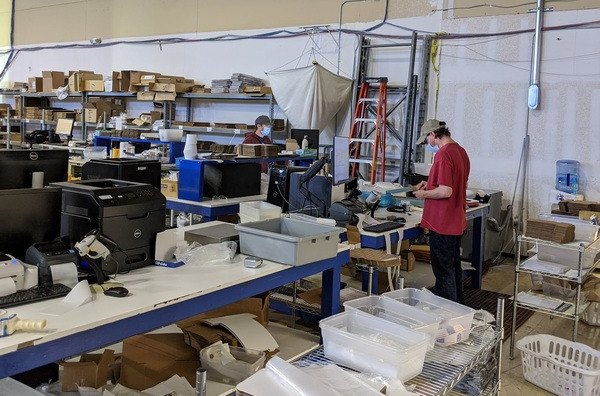 |
Pololu shipping department on 6 April 2020. |
|---|
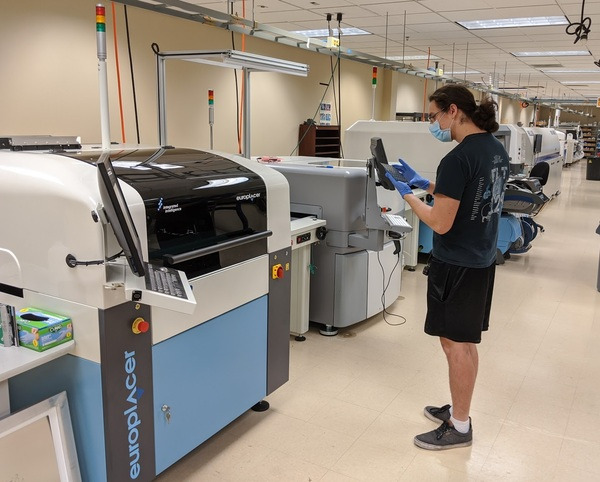 |
Pololu SMT pick and place production line on 6 April 2020. |
|---|
 |
Soldering at Pololu on 6 April 2020. |
|---|
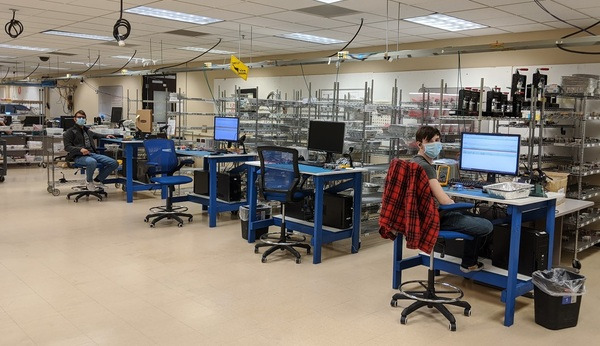 |
Pololu testing department on 6 April 2020. |
|---|
How you can help
Make a donation
If you can, please consider donating to help Pololu make it. We have set up item 2400 for donating in $1 increments.
Pay now, ship later
We have added a feature to our online checkout system to allow for orders to be placed with a “pay now, ship later” option that lets you authorize us to charge the payment for an order as soon as it comes in, possibly well ahead of when the order would actually ship. We started working on this feature at a time when we thought complete shutdown of our operations was imminent, when it might have been weeks or even months before we could reopen. As I wrote at the top of this update, we have been able to ship all orders, and I expect to continue shipping, but this option still allows us to prioritize shipments and reduce stress with orders that come in later in the day and can get shipped the next day. We have already received dozens of orders with this option selected, and it is also encouraging just to see that our customers are trying to help us out. Thank you to all of you who have selected that option!
Order non-soldered versions of products, or the higher-stock versions
We offer a few of our products with some of the optional (but usually used) through-hole connectors soldered in. If you are able to solder, please consider ordering the non-soldered versions if there is plentiful stock of them. We do all of the through-hole soldering by hand, and most of our manual assemblers were older or otherwise in the higher-risk population for COVID-19, so they are not currently working here. And if you’re at home doing a non-critical project, now is a good time to do a little extra soldering, right?
On a related note, it’s a little bit easier for us if you order the item that has more stock. Each product page has links to relevant parametric comparison tables that can help you identify similar products that might have more available stock:
 |
You can check available quantity of similar products on the parametric comparison table. |
|---|
If your application could get by with either an item of which we have 300 in stock or one of which we have 12 units, please get the product that we have much more of. It’s probably a more popular version that we make more often, and it keeps the less popular version available for those who might really need it.
Help each other on our forum
We have had to severely cut back on our technical support. If you are one those people with extra time on your hands now and are familiar with any of our products, please consider helping out our other customers on our forum.
Ask others to help us out
If you know anybody that could afford to help us out, please let them know and ask them to contribute.
Other suggestions and ideas
Part of the reason I have been going into more details in some areas of these updates is so you might be able to better give us advice about how we could make things better. Maybe you’re also working at a small business facing similar challenges, and you have some good suggestions. Maybe your uncle has a vacant building nearby. One suggestion I’ve heard repeatedly is about gift certificates, which we are looking into; if you know of particularly good ways of implementing that or things to be careful about, please let us know.
Thank you all for your support. Stay safe and healthy, everybody!
Monday, 13 April 2020 update – we got our PPP loan!
Coronavirus impact update: still shipping all orders
Quick summary: Pololu has filled all orders and continues to operate, including shipping products to important customers fighting COVID-19 around the world. Thank you for all of your help and donations, which are really making a difference. We are preparing for extended operations under emergency conditions and evaluating all available avenues for support. Cash donations remain the most useful and immediate way to help, but there are other ways you can help us. Donate here.
Please see new update posted Monday, 6 April 2020.
 |
Still shipping, 30 March 2020. |
|---|
It has been a week since I posted about Pololu’s dire circumstances brought about by the new coronavirus pandemic. My outlook today is much more positive than it was back then, in large part thanks to the support we have received during the past week. We are by no means out of the woods yet, as a company, as a country, and as a planet. I write today’s post to provide an update on how we are doing, to try to address the questions I am getting repeated from many people, to share our general outlook for moving forward, and to renew my appeal for help in any way possible. Since there are many topics that might be of varying degrees of interest to each of you, I will try to organize this with more sections and headings:
- We are still operating, with every order shipped!
- Thank you to everyone who has donated
- Updates about common questions
- Outlook and plan for now
- How you can help
We are still operating and have shipped every order!
We have operated for eight business days now with a skeleton crew of approximately 20 staff members on site and 10-20 more people assisting via remote connections from home. We have shipped every order for in-stock items that has been placed during that time, and we have limited production capacity for special orders beyond what is in stock.
We have had no new local business shutdown orders that would affect us since Friday the 20th, and we have received dozens if not hundreds of customer requests and certifications from customers that have been declared essential businesses or services within their jurisdictions, and as suppliers to those organizations, we are essential by extension as well. We also continue to get many confirmations of our products and services (e.g. laser cutting) being used directly in the response to the COVID-19 pandemic, so we will keep shipping orders as long as delivery services keep operating.
You can see available stock for each product live on our website, and if your order consists of just in-stock items, we should be able to ship your order within a day.
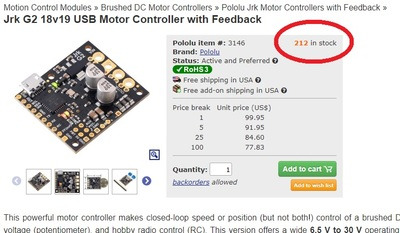 |
Available stock is shown on each product page. |
|---|
Each product page has links to relevant parametric comparison tables that can help you identify similar products that might have more available stock:
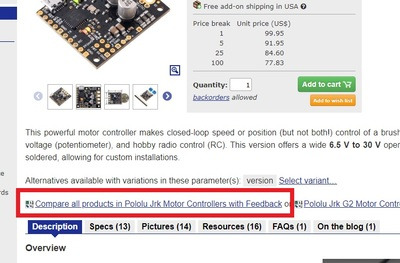 |
Each product page has links to relevant parametric comparison tables. |
|---|
 |
You can check available quantity of similar products on the parametric comparison table. |
|---|
Our China facility in Shenzhen is also partially operational, and we are able to ship some special volume orders directly from there. The available shipping carriers and destinations are changing day by day as countries respond to the pandemic, but we are working with customers to route critical orders as quickly as possible. Please note that all of our electronics products are manufactured at our Las Vegas, Nevada, USA facility, so shipments directly from China are only available for select products, mostly motors and other mechanical components that we have machined or injection molded there.
We also have hundreds of distributors around the world that might be operational and have stock closer to you. We will be working with them in the coming days to update the distributors page with information about those businesses confirmed to still be in operation.
Thank you to everyone who has donated!
We have received thousands of dollars in donations since my original post. I have tried to send at least a few personal thank you emails every day, but there have been more donations than I can keep up with. It is extremely motivating to see the breadth of donations we are receiving from all over the world, from customers we haven’t heard from in a long time, to family members of employees, to former employees, to people that, as far as we can tell, have had no previous association with Pololu. To all of you whom I have not thanked yet individually, thank you!!! I am making sure everyone at Pololu knows about your support. The value of the money we receive in donations is multiplied both by the psychological boost it gives us and by getting factored into various lines of credit that we have available to us that are automatically calculated based on the rolling average revenue appearing in our accounts.
Several Pololu employees who are part of our continuing operations have volunteered reductions in their own pay so that we might conserve our limited cash on hand and continue payments and insurance for those employees that are most in need. PT from Adafruit also responded to my call for help and gave me some useful perspective and helped spread the word about our situation even as Adafruit conducted its own emergency operations out of New York, the US epicenter of the coronavirus outbreak.
The donations and support are all the more meaningful at a time like this, where nearly everyone is impacted and the future so uncertain.
If you can, please consider donating to help Pololu make it through this difficult time. You can use item 2400 to donate in $1 increments. I will also post other ways you can help us at the end of this update.
Updates about common questions
Landlord and building situation
After payroll, the building rent is our biggest expense and obligation, so I of course reached out to my landlord right away to see what their position was. Unfortunately, the building we are in was just sold in the last 6 months, so we do not have the long working history we had with the previous landlord. I am posting a little more detail here than I would normally be comfortable with, but we are in an extraordinary emergency and I am hearing the same questions and suggestions from multiple people, so I want to share this information because I believe it could be useful in getting us help and advice.
 |
We are the only tenant in a building that is approximately 86,000 square feet. The building had been vacant, I think for years, after the previous economic downturn, and we moved in here at the end of 2011, taking part of the first floor. In 2013, the landlord received an offer for the second floor. It was a time when we were growing rapidly, and the building was not at all well set up for sharing with multiple tenants, so we made the owner an offer for the space and reached an agreement that was expensive but affordable for us and at a lower rate for the landlord than the competing offer but without the need to do any new construction. Over the next several years, we agreed to extensions in the lease and a gradual takeover of the remainder of the first floor, so that we would officially have the building to ourselves and the landlord could stop looking for other tenants to fill the remaining space.
In 2018, we negotiated a new extension of the lease. The building was still in its as-is state from 2009 or whenever the previous tenants moved out, and it was a particularly impractical floorplan based on the previous tenant’s operations. The landlord preferred putting some money into renovating the space and increasing our rent over keeping the rent at a bare minimum, and so even though our cost went up again, we were getting a more usable space with plenty of room for growth at still a decent total cost. The renovations took longer than expected and ran through most of 2019. Some kind of family change caused the landlord to unexpectedly have to sell the building, which got us to where we are today: with a new owner, in a building that is bigger than we need but well set up for us, and with what I think is a pretty good rate.
The new landlord thinks it’s an incredibly good rate and thinks the market rate (of course before this pandemic hit) should be closer to double what we are paying now. We have more than four more years left on our lease, and from his perspective, he might even prefer us to be out of the building. I suspect he has dozens or even more tenants from all over suddenly asking for reductions or notifying him that they won’t be able to make rent, and given his view of what we are paying relative to what the space is worth, we are going to be low on the list of tenants he wants to make special exceptions for. So for now, if we believe we can be back to full operation in the next few months and then resume the growth path we were on, it is very important for us not to give the landlord any pretext for evicting us. I realize some of what he told me might be for negotiation, but I believe he was generally up-front with me. (And I’ve been using the singular “owner” or “landlord” or “he” for the landlord in both the current and previous landlord cases, but really I am talking about my contacts for the ownership groups.)
I related the history of how we got here so that people who know more about this kind of thing might be able to give me better advice and so that people who look at some of the pictures I am posting don’t feel that we are wasting money on an extravagant work space. Yes, we could fit our current operations into a 50,000 square foot space. But building rent agreements can be quite long-term, and with the amount we have invested in equipment and improvements here, moving would be very expensive, even if we could find an appropriate space. And the value of our contract depends a lot on how things play out. If there is a long-term depression that we cannot survive, the contract is an anchor that will drag us down and potentially finish us. If things get better relatively quickly, the contract protects us and gives us stability, letting us operate at a relatively good rate, without having to interrupt everything to move.
I should also make sure it’s clear that I completely understand my landlord’s perspective (who of course has his own mortgages and employees to keep paying), and it’s good to know that he’s open to arrangements that could be mutually beneficial. Perhaps some more spaces will open up as other businesses close, and if we get forced to stop operating for an extended period of time, that interruption might also be a good time to move. For the time being, though, I think we just need to hang on for a few months, and if that is the case, we have to keep paying the full rent.
Stimulus bill and SBA disaster loan
After days of trying on the overloaded SBA disaster loan website, we got our loan application submitted at 2:30AM on Tuesday. It’s not clear how long it will be before there is some progress with that or how much assistance we would qualify for.
We are also paying attention to the new stimulus bill that was just passed to see how it might apply to us. So far, it looks like it will be at least a few more weeks before the details get worked out to a level that we can do something with. The initial impression I am getting is that the way the support is structured, we might be incentivized to do things that would be bad for us if the support doesn’t pan out. For example, it is paramount for us to cut back on expenditures so that we have some cash to pay the most critical bills as long as possible. That includes laying off non-essential staff right away. Yet that might reduce or even eliminate some of the support we might qualify for.
There’s also a huge difference between getting a loan and that loan being forgiven. If the model for our collective response to the pandemic is that the government orders us to pause operations, then gives me money to distribute to my employees, I am happy to do my part in that arrangement. If, on the other hand, the proposal amounts to me personally being on the hook for the rest of my life to pay back a loan I took just to pay people that weren’t allowed to work, that’s not actually helping, and it would make more sense for those employees to just get paid directly from the unemployment aspects of the support bill.
We might also be facing a situation where the new support measures might encourage people who could be working to stay home and collect unemployment instead. So far, we have gotten by without pushing anyone who does not want to be here to be here. This will be a challenge for society in general as we all try to pause and then recover in this unprecedented situation. Many individuals want to work, but it might be better for the community if they don’t, and in compensating them for preventing them from working, we might be discouraging other people whom we do need to be working.
Outlook and plan for now
The past two weeks of operation have made me optimistic that we could keep operating as we have for at least several more months. This past week was especially good because we had relative stability in how we operated, and it allowed us to spend a little time on getting ahead and start preparing for operating under these emergency measures for an extended period. A few engineers who had been working on production processes and were out the first week came in and started assessing our workflow with new distancing and isolation considerations. Having a lot of space is coming in handy, at least in terms of making it easier for people to work far apart from each other. We gathered in the same room once during the whole time, to select permanent spots in the break room:
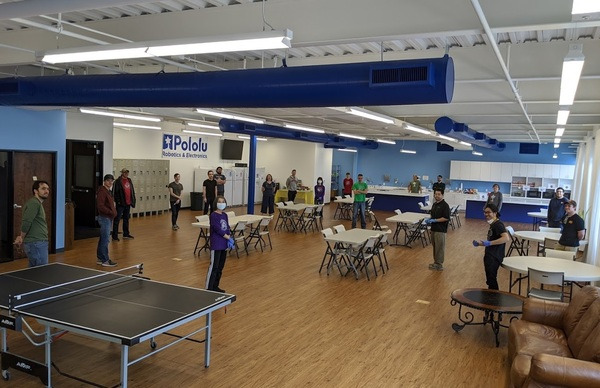 |
Pololu skeleton crew permanent table assignment meeting, March 2020. |
|---|
(Those who have individual offices are encouraged to eat there, but in general, those are the people who are already home and connected remotely.)
We are also working on improving remote connection and working options where possible, including getting more computers and monitors to employees’ homes.
With the outlook unclear on how much government support we might get and when, it’s clear we need to transition to an operating mode where we can be largely self-sufficient financially without burning out before we get there. Here, the donations we have received have been tremendously helpful in buying us time to get back on our feet.
If you can, please consider donating to help Pololu make it. We have set up item 2400 for donating in $1 increments.
Other ways you can help
Pay now, ship later
In the past week, we added a feature to our online checkout system to allow for orders to be placed with a “pay now, ship later” option that lets you authorize us to charge the payment for an order as soon as it comes in, possibly well ahead of when the order would actually ship. We started working on this feature at a time when we thought complete shutdown of our operations was imminent, when it might have been weeks or even months before we could reopen. As I wrote at the top of this update, we have been able to ship all orders, and I expect to continue shipping, but this option still allows us to prioritize shipments and reduce stress with orders that come in later in the day and can get shipped the next day. We have already received dozens of orders with this option selected, and it is also encouraging just to see that our customers are trying to help us out. Thank you to all of you who have selected that option!
Order non-soldered versions of products, or the higher-stock versions
We offer a few of our products with some of the optional (but usually used) through-hole connectors soldered in. If you are able to solder, please consider ordering the non-soldered versions if there is plentiful stock of them. We do all of the through-hole soldering by hand, and most of our manual assemblers were older or otherwise in the higher-risk population for COVID-19, so they are not currently working here. And if you’re at home doing a non-critical project, now is a good time to do a little extra soldering, right?
On a related note, it’s a little bit easier for us if you order the item that has more stock. Going back to the screenshot I have at the beginning of this post, it’s easy to see our stock levels of similar products:
 |
You can check available quantity of similar products on the parametric comparison table. |
|---|
If your application could get by with either an item of which we have 300 in stock or one of which we have 12 units, please get the product that we have much more of. It’s probably a more popular version that we make more often, and it keeps the less popular version available for those who might really need it.
Help each other on our forum
We have had to severely cut back on our technical support. If you are one those people with extra time on your hands now and are familiar with any of our products, please consider helping out our other customers on our forum.
Ask others to help us out
If you know anybody that could afford to help us out, please let them know and ask them to contribute.
Other suggestions and ideas
Part of the reason I went into more details in some areas is so you might be able to better give us advice about how we could make things better. Maybe you’re also working at a small business facing similar challenges, and you have some good suggestions. Maybe your uncle has a vacant building nearby. One suggestion I’ve heard repeatedly is about gift certificates, which we are looking into; if you know of particularly good ways of implementing that or things to be careful about, please let us know.
Thank you all for your support. Stay safe and healthy, everybody!
Please see new update posted Monday, 6 April 2020.
